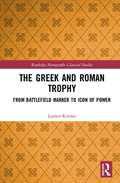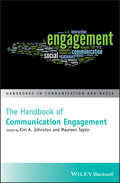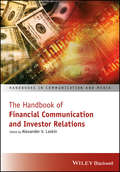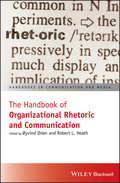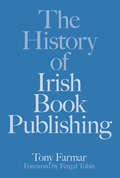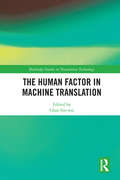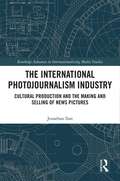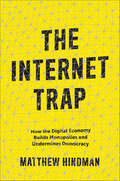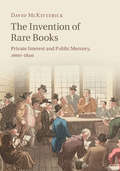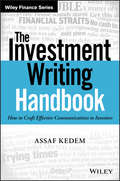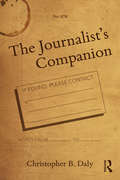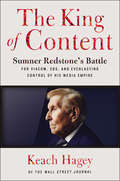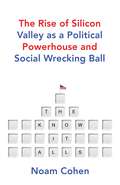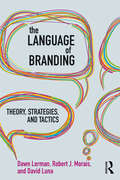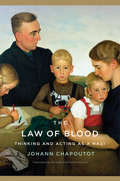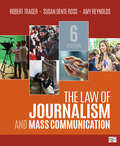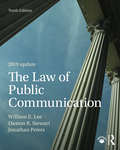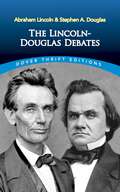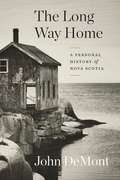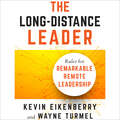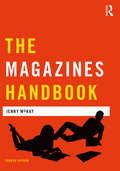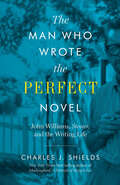- Table View
- List View
The Greek and Roman Trophy: From Battlefield Marker to Icon of Power (Routledge Monographs in Classical Studies)
by Lauren KinneeIn The Greek and Roman Trophy: From Battlefield Marker to Icon of Power, Kinnee presents the first monographic treatment of ancient trophies in sixty years. The study spans Archaic Greece through the Augustan Principate. Kinnee aims to create a holistic view of this complex monument-type by breaking down boundaries between the study of art history, philology, the history of warfare, and the anthropology of religion and magic. Ultimately, the kaleidoscopic picture that emerges is of an ad hoc anthropomorphic Greek talisman that gradually developed into a sophisticated, Augustan sculptural or architectural statement of power. The former, a product of the hoplite phalanx, disappeared from battlefields as the Macedonian cavalry grew in importance, shifting instead onto coins and into rhetoric, where it became a statement of military might. For their part, the Romans seem to have encountered the trophy as an icon on Syracusan coinage. Recognizing its value as a statement of territorial ownership, the Romans spent two centuries honing the trophy-concept into an empire-building tool, planted at key locations around the Mediterranean to assert Roman presence and dominance. This volume covers a ubiquitous but poorly understood phenomenon and will therefore be instructive to upper-level undergraduates, graduate students, and scholars in all fields of Classical Studies.
The Handbook of Communication Engagement (Handbooks in Communication and Media)
by Maureen Taylor Kim A. JohnstonA comprehensive volume that offers the most current thinking on the practice and theory of engagement With contributions from an international panel of leaders representing diverse academic and professional fields The Handbook of Communication Engagement brings together in one volume writings on both the theory and practice of engagement in today’s organizations and societies. The expert contributors explore the philosophical, theoretical, and applied concepts of communication engagement as it pertains to building interaction and connections in a globalized, networked society. The Handbook of Communication Engagement is comprehensive in scope with case studies of engagement from various disciplines including public relations, marketing, advertising, employee relations, education, public diplomacy, and politics. The authors advance the current thinking in engagement theory, strategy, and practice and provide a review of foundational and emerging research in engagement topics. The Handbook of Communication Engagement is an important text that: Provides an overview of the foundations and philosophies of engagement Identifies the contexts of engagement relating to specific areas across government and corporations, including CSR, consumer, activism, diplomacy, digital, and social impact Includes examples of contemporary engagement practice Presents applications of engagement and technology Offers insights on the future directions of engagement The Handbook of Communication Engagement offers an essential reference for advanced undergraduate, graduate students, practitioners and scholars from communication, media, advertising, public relations, public policy, and public diplomacy areas. The volume contains a compendium of the writings on the most recent advances on the theory and practice of engagement. Winner of the 2018 PRIDE Award for Innovation, Development, and Educational Achievement from the Public Relations Division of the National Communication Association.
The Handbook of Financial Communication and Investor Relations
by Alexander V. LaskinThe first book to offer a global look at the state-of-the-art thinking and practice in investor relations and financial communication Featuring contributions from leading scholars and practitioners in financial communication and related fields--including public relations, corporate communications, finance, and accounting-- this volume in the critically acclaimed "Handbooks in Communication and Media" seriesprovides readers with a comprehensive, up-to-date picture of investor relations and financial communications as they are practiced in North America and around the world. The Handbook of Financial Communication and Investor Relations provides an overview of the past, present, and future of investor relations and financial communications as a profession. It identifies the central issues of contemporary investor relations and financial communications practice, including financial information versus non-financial information, intangibles, risk, value, and growth. Authors address key topics of concern to contemporary practitioners, such as socially responsible investing, corporate governance, shareholder activism, ethics, and professionalism. In addition, the book arms readers with metrics and proven techniques for reliably measuring and evaluating the effectiveness of investor relations and financial communications. Bringing together the most up-to-date research on investor relations and financial communication and the insights and expertise of an all-star team of practitioners, The Handbook of Financial Communication and Investor Relations: Explores how the profession is practiced in various regions of the globe, including North America, South America, Europe, the Middle East, India, Australia, and other areas Provides a unique look at financial communication as it is practiced beyond the corporate world, including in families, the medical profession, government, and the not-for-profit sector Addresses "big-picture" strategies as well as specific tactics for financial communication during crises, the use of social media, dealing with shareholder activism, integrated reporting and CSR, and more This book makes an ideal reference resource for undergrads and graduate students, scholars, and practitioners studying or researching investor relations and financial communication across schools of communication, journalism, business, and management. It also offers professionals an up-to-date, uniquely holistic look at best practices in financial communication investor relations worldwide.
The Handbook of Organizational Rhetoric and Communication (Handbooks in Communication and Media)
by Yvind Ihlen X00D8 Robert L HeathA one-stop source for scholars and advanced students who want to get the latest and best overview and discussion of how organizations use rhetoric While the disciplinary study of rhetoric is alive and well, there has been curiously little specific interest in the rhetoric of organizations. This book seeks to remedy that omission. It presents a research collection created by the insights of leading scholars on rhetoric and organizations while discussing state-of-the-art insights from disciplines that have and will continue to use rhetoric. Beginning with an introduction to the topic, The Handbook of Organizational Rhetoric and Communication offers coverage of the foundations and macro-contexts of rhetoric—as well as its use in organizational communication, public relations, marketing, management and organization theory. It then looks at intellectual and moral foundations without which rhetoric could not have occurred, discussing key concepts in rhetorical theory. The book then goes on to analyze the processes of rhetoric and the challenges and strategies involved. A section is also devoted to discussing rhetorical areas or genres—namely contextual application of rhetoric and the challenges that arise, such as strategic issues for management and corporate social responsibility. The final part seeks to answer questions about the book’s contribution to the understanding of organizational rhetoric. It also examines what perspectives are lacking, and what the future might hold for the study of organizational rhetoric. Examines the advantages and perils of organizations that seek to project their voices in order to shape society to their benefits Contains chapters working in the tradition of rhetorical criticism that ask whether organizations’ rhetorical strategies have fulfilled their organizational and societal value Discusses the importance of obvious, traditional, nuanced, and critically valued strategies such as rhetorical interaction in ways that benefit discourse Explores the potential, risks, paradoxes, and requirements of engagement Reflects the views of a team of scholars from across the globe Features contributions from organization-centered fields such as organizational communication, public relations, marketing, management, and organization theory The Handbook of Organizational Rhetoric and Communication will be an ideal resource for advanced undergraduate students, graduate students, and scholars studying organizational communications, public relations, management, and rhetoric.
The History of Irish Book Publishing
by Conor Kostick Tony FarmarThe story of how books in all their variety, from mathematics textbooks to murder mysteries, reach the hands of readers is a significant one. This is especially so in Ireland, where Irish publishing houses battle to flourish and survive through economic crises and in a market dominated by British publishers. The paradox of publishing, writes Tony Farmar, is that though it is a business, and a risky business everywhere, it is much more than that. Publishers’ ‘gatekeeping, encouragement and investing’ help to shape what has been called a country’s ‘mentalities’. Thus the importance of a flourishing local publishing industry, especially those that share a language with an ‘over-mighty neighbour’. The product of many years of research, this book focuses on the years from 1890 and includes a detailed chronicle of the key dates and events in the development of Irish book publishing. The final chapter, by Conor Kostick, covers the period from 2008 to 2018. What emerges is a vivid portrait of how the Irish book publishing industry contributed and continues to contribute in immeasurable ways to the intellectual and cultural life of Ireland.
The Human Factor in Machine Translation (Routledge Studies in Translation Technology)
by Sin-Wai ChanMachine translation has become increasingly popular, especially with the introduction of neural machine translation in major online translation systems. However, despite the rapid advances in machine translation, the role of a human translator remains crucial. As illustrated by the chapters in this book, man-machine interaction is essential in machine translation, localisation, terminology management, and crowdsourcing translation. In fact, the importance of a human translator before, during, and after machine processing, cannot be overemphasised as human intervention is the best way to ensure the translation quality of machine translation. This volume explores the role of a human translator in machine translation from various perspectives, affording a comprehensive look at this topical research area. This book is essential reading for anyone involved in translation studies, machine translation or interested in translation technology.
The International Photojournalism Industry: Cultural Production and the Making and Selling of News Pictures (Routledge Advances in Internationalizing Media Studies)
by Jonathan IlanHow are events turned into news pictures that define them for the audience? How do events become commodified into pictures that both capture them and reiterate the values of the agencies that sell them? This book looks at every stage of the production of news photographs as they move to and from the ground and are sold around the world. Based on extensive fieldwork at a leading international news agency that includes participant observation with photographers in the field, at the agency’s local and global picture desks in Israel, Singapore, and the UK, in-depth interviews with pictures professionals, and observations and in-depth interviews at The Guardian’s picture desk in London, the findings in this book point to a wide cultural production infrastructure hidden from – and yet also nurtured and thus very much determined by – the consumer’s eye.
The Internet Trap: How the Digital Economy Builds Monopolies and Undermines Democracy
by Matthew HindmanA book that challenges everything you thought you knew about the online economyThe internet was supposed to fragment audiences and make media monopolies impossible. Instead, behemoths like Google and Facebook now dominate the time we spend online—and grab all the profits from the attention economy. The Internet Trap explains how this happened. This provocative and timely book sheds light on the stunning rise of the digital giants and the online struggles of nearly everyone else—and reveals what small players can do to survive in a game that is rigged against them.Matthew Hindman shows how seemingly tiny advantages in attracting users can snowball over time. The internet has not reduced the cost of reaching audiences—it has merely shifted who pays and how. Challenging some of the most enduring myths of digital life, Hindman explains why the internet is not the postindustrial technology that has been sold to the public, how it has become mathematically impossible for grad students in a garage to beat Google, and why net neutrality alone is no guarantee of an open internet. He also explains why the challenges for local digital news outlets and other small players are worse than they appear and demonstrates what it really takes to grow a digital audience and stay alive in today’s online economy.The Internet Trap shows why, even on the internet, there is still no such thing as a free audience.
The Invention of Rare Books: Private Interest and Public Memory, 1600–1840
by David McKitterickWhen does a book that is merely old become a rarity and an object of desire? David McKitterick examines, for the first time, the development of the idea of rare books, and why they matter. Studying examples from across Europe, he explores how this idea took shape in the sixteenth and seventeenth centuries, and how collectors, the book trade and libraries gradually came together to identify canons that often remain the same today. In a world that many people found to be over-supplied with books, the invention of rare books was a process of selection. As books are one of the principal means of memory, this process also created particular kinds of remembering. Taking a European perspective, McKitterick looks at these interests as they developed from being matters of largely private concern and curiosity, to the larger public and national responsibilities of the first half of the nineteenth century.
The Investment Writing Handbook: How to Craft Effective Communications to Investors (Wiley Finance)
by Assaf KedemThe writing "bible" for financial professionals The Investment Writing Handbook provides practical, accessible guidance for crafting more effective investor communications. Written by an award-winning writer, editor, and speechwriter, this book explains the principles and conventions that help writing achieve its purpose; whether you need to inform, educate, persuade, or motivate, you'll become better-equipped to develop a broad range of communications and literature for investor consumption. Examples from real-world financial institutions illustrate expert execution, while explanations and advice targeted specifically toward investor relations give you the help you need quickly. From white papers and investment commentary to RFPs, product literature, and beyond, this book is the financial writer's "bible" that you should keep within arm's reach. Investment writing is one of the primary influences on investors' attitudes. It educates, informs decisions, shapes opinions, and drives behavior—so shouldn't it be expertly-crafted to achieve its intended goal? This book explains the "tricks of the trade" to help you get your message across. Understand the principles of effective investor communication Master the conventions of informative and persuasive writing Examine well-written sample documents from real-world institutions Improve research papers, presentations, investor letters, marketing literature, and more Virtually all firms with investors as clients need to communicate to them regularly, but few financial professionals receive formal training in investor communications. When investors' opinions, attitudes, and actions determine the health of your company, it is vitally important that these communications not be left to chance. The Investment Writing Handbook provides essential guidance and clear explanations to help you transform your communication strategy, execution, and results.
The Journalist's Companion
by Christopher B. DalyThe Journalist’s Companion is the book for every journalist and journalism student’s coat pocket or backpack. Anchored by an annotated copy of the U.S. Constitution, this slim and portable volume provides guidance, inspiration, and practical advice for being a journalist today. A veteran front-line news reporter and professor of journalism for another twenty years, Christopher B. Daly has seen the attempts to silence and intimidate journalists. The Journalist’s Companion gives reporters, editors, and students the inspiration to stand tall along with advice to do their work well, accurately, and fearlessly. This book also includes a brief guide on how to file a Freedom of Information Act demand, a checklist for reporters and editors designed to increase the level of accuracy in their work, a primer on copyright and professional courtesy, and a quick guide to staying safe while on assignment.
The King of Content: Sumner Redstone's Battle for Viacom, CBS, and Everlasting Control of His Media Empire
by Keach Hagey“An epic story . . . filled with legal conflicts, boardroom battles, angry ex-girlfriends, family drama and a ninety-five-year-old media mogul.” —The Washington PostSumner Murray Redstone, who lived by the credo “content is king,” leveraged his father’s chain of drive-in movie theaters into one of the world’s greatest media empires through a series of audacious takeovers designed to ensure his permanent control. Over the course of this meteoric rise, he made his share of enemies and feuded with nearly every member of his family.In The King of Content, Wall Street Journal reporter Keach Hagey deconstructs Redstone’s rise from Boston’s West End through Harvard Law School to the highest echelons of American business. The mogul’s life became a tabloid soap opera, the center of acrimonious legal battles throughout his vast holdings, which included Paramount Pictures and two of the largest public media companies, Viacom and CBS. At the heart of these lawsuits was Redstone’s tumultuous love life and complicated relationship with his children. Redstone’s daughter, Shari, has emerged as his de facto successor, but only after she ousted his closest confidant in a fierce power struggle.Yet Redstone’s assets face an existential threat that goes beyond his family, disgruntled ex-girlfriends, or even the management of his companies: the changing nature of media consumption. As more people cut their cable cords, CBS, with its focus on sports and broadcast TV, has held steady, while Viacom, with its once-great cable channels like MTV and Nickelodeon, has suffered a precipitous fall. As their rivals merge, the question is whether Shari’s push to undo her father’s last big strategic maneuver and recombine CBS and Viacom will be enough to shore up their future.A biography and corporate whodunit filled with surprising details, The King of Content investigates Redstone’s impact on business and popular culture, as well as the family feuds, corporate battles, and questionable alliances that go back decades—all laid bare in this authoritative book.
The Know-It-Alls: The Rise of Silicon Valley as a Political Powerhouse and Social Wrecking Ball
by Noam CohenThe world&’s tech giants are at the centre of controversies over fake news, free speech and hate speech on platforms where influence is bought and sold. Yet, at the outset, almost everyone thought the internet would be a positive, democratic force, a space where knowledge could be freely shared to enable everyone to make better-informed decisions. How did it all go so wrong? Noam Cohen reports on the tech libertarians of Silicon Valley, from the self-proclaimed geniuses Jeff Bezos, Peter Thiel, Reid Hoffman and Mark Zuckerberg to the early pioneers at Stanford University, who have not only made the internet what it is today but reshaped society in the process. It is the story of how the greed, bias and prejudice of one neighbourhood is fracturing the Western world.
The Language of Branding: Theory, Strategies, and Tactics
by Dawn Lerman Robert J. Morais David LunaThe Language of Branding: Theory, Strategies and Tactics shows marketers how to use language successfully to improve brand value and influence consumer behavior. Luna and Lerman are among only a few researchers who take a multidisciplinary perspective on the ways language influences how consumers act. Together with Morais, an anthropologist engaged in market research, they show how understanding the power of language can impact the essence – and sales – of a brand. The book covers the fundamentals of brand language and applications for an array of marketing initiatives. Readers will learn why brand language matters, how language is used in marketing, and how to build a brand strategy that capitalizes on the richness and complexity of language. This book includes real-world case histories that demonstrate vividly how brand language is created and exercises that enable both students of marketing and marketing professionals to apply the book’s concepts and stimulate class discussion. The Language of Branding: Theory, Strategies and Tactics can be used in a number of courses, including consumer behavior, branding, advertising, linguistics, and communications.
The Law of Blood: Thinking and Acting as a Nazi
by Johann ChapoutotThe scale and the depth of Nazi brutality seem to defy understanding. What could drive people to fight, kill, and destroy with such ruthless ambition? Observers and historians have offered countless explanations since the 1930s. According to Johann Chapoutot, we need to understand better how the Nazis explained it themselves. We need a clearer view, in particular, of how they were steeped in and spread the idea that history gave them no choice: it was either kill or die. Chapoutot, one of France’s leading historians, spent years immersing himself in the texts and images that reflected and shaped the mental world of Nazi ideologues, and that the Nazis disseminated to the German public. The party had no official ur-text of ideology, values, and history. But a clear narrative emerges from the myriad works of intellectuals, apparatchiks, journalists, and movie-makers that Chapoutot explores. The story went like this: In the ancient world, the Nordic-German race lived in harmony with the laws of nature. But since Late Antiquity, corrupt foreign norms and values—Jewish values in particular—had alienated Germany from itself and from all that was natural. The time had come, under the Nazis, to return to the fundamental law of blood. Germany must fight, conquer, and procreate, or perish. History did not concern itself with right and wrong, only brute necessity. A remarkable work of scholarship and insight, The Law of Blood recreates the chilling ideas and outlook that would cost millions their lives.
The Law of Blood: Thinking and Acting as a Nazi
by Johann ChapoutotThe scale and the depth of Nazi brutality seem to defy understanding. What could drive people to fight, kill, and destroy with such ruthless ambition? Observers and historians have offered countless explanations since the 1930s. According to Johann Chapoutot, we need to understand better how the Nazis explained it themselves. We need a clearer view, in particular, of how they were steeped in and spread the idea that history gave them no choice: it was either kill or die. Chapoutot, one of France’s leading historians, spent years immersing himself in the texts and images that reflected and shaped the mental world of Nazi ideologues, and that the Nazis disseminated to the German public. The party had no official ur-text of ideology, values, and history. But a clear narrative emerges from the myriad works of intellectuals, apparatchiks, journalists, and movie-makers that Chapoutot explores. The story went like this: In the ancient world, the Nordic-German race lived in harmony with the laws of nature. But since Late Antiquity, corrupt foreign norms and values—Jewish values in particular—had alienated Germany from itself and from all that was natural. The time had come, under the Nazis, to return to the fundamental law of blood. Germany must fight, conquer, and procreate, or perish. History did not concern itself with right and wrong, only brute necessity. A remarkable work of scholarship and insight, The Law of Blood recreates the chilling ideas and outlook that would cost millions their lives.
The Law of Journalism and Mass Communication
by Amy L. Reynolds Robert E. Trager Susan D. RossThe Law of Journalism and Mass Communication, Sixth Edition, by Robert Trager, Susan Dente Ross, and Amy Reynolds offers a clear and engaging introduction to media law with comprehensive coverage and analysis of key cases for future journalists and media professionals. You are introduced to key legal issues at the start of each chapter, building your critical thinking skills before progressing to real-world landmark cases that demonstrate how media law is applied today. Contemporary examples, emerging legal topics, international issues, and cutting-edge research all help you to retain and apply principles of media law in practice. The thoroughly revised Sixth Edition has been reorganized and shortened to 12 chapters, streamlining the content and offering instructors more opportunities for classroom activities. This edition also goes beyond the judiciary—including discussions of tweets and public protests, alcohol ads in university newspapers, global data privacy and cybersecurity, libel on the internet, and free speech on college campuses—to show how the law affects the ways mass communication works and how people perceive and receive that work.
The Law of Journalism and Mass Communication
by Amy L. Reynolds Robert E. Trager Susan D. RossThe Law of Journalism and Mass Communication, Sixth Edition, by Robert Trager, Susan Dente Ross, and Amy Reynolds offers a clear and engaging introduction to media law with comprehensive coverage and analysis of key cases for future journalists and media professionals. You are introduced to key legal issues at the start of each chapter, building your critical thinking skills before progressing to real-world landmark cases that demonstrate how media law is applied today. Contemporary examples, emerging legal topics, international issues, and cutting-edge research all help you to retain and apply principles of media law in practice. The thoroughly revised Sixth Edition has been reorganized and shortened to 12 chapters, streamlining the content and offering instructors more opportunities for classroom activities. This edition also goes beyond the judiciary—including discussions of tweets and public protests, alcohol ads in university newspapers, global data privacy and cybersecurity, libel on the internet, and free speech on college campuses—to show how the law affects the ways mass communication works and how people perceive and receive that work.
The Law of Public Communication
by William E. Lee Kent R. Middleton Daxton R. StewartNow in its tenth edition, The Law of Public Communication provides an overview of media law that includes the most current legal developments. It explains the laws affecting the daily work of writers, broadcasters, PR practitioners, photographers, and other public communicators. By providing statutes and cases in an accessible manner, even to students studying law for the first time, the authors ensure that students will acquire a firm grasp of the legal issues affecting the media. This new edition features color photos, as well as breakout boxes that apply the book’s principles to daily life. The new case studies discussed often reflect new technologies and professional practices.
The Lincoln-Douglas Debates (Dover Thrift Editions)
by Abraham Lincoln Stephen A. Douglas Edwin Erle SparksOne of the most significant and far-reaching events in U. S. history, the Lincoln-Douglas debates of 1858 sharpened and brought to a head a number of crucial questions concerning slavery, states' rights, the legal status of blacks, and the effects of the Dred Scott decision. The debates were held as part of the campaign for the Illinois senatorial seat, pitting the two-term incumbent, Democrat Stephen A. Douglas, against the lesser-known Abraham Lincoln, a successful lawyer and former state politician who was the Republican candidate.Paving the way for modern discussions between political candidates, the Lincoln-Douglas debates fascinated nineteenth-century America and catapulted Lincoln into the spotlight. Although he lost the race to Douglas, the stature and recognition Lincoln gained during the exchanges helped propel him to the presidency in 1860, just two years later. This volume features rousing speeches by each candidate and the rejoinders and replies.
The Long Way Home: A Personal History of Nova Scotia
by John DemontThe province's premier journalist tells the story he was born to write.No journalist has travelled the back roads, hidden vales and fog-soaked coves of Nova Scotia as widely as John DeMont. No writer has spent as much time considering its peculiar warp and weft of humanity, geography and history. The Long Way Home is the summation of DeMont's years of travel, research and thought. It tells the story of what is, from the European view of things, the oldest part of Canada. Before Confederation it was also the richest, but now Nova Scotia is among the poorest. Its defining myths and stories are mostly about loss and sheer determination. Equal parts narrative, memoir and meditation, The Long Way Home chronicles with enthralling clarity a complex and multi-dimensional story: the overwhelming of the first peoples and the arrival of a mélange of pioneers who carved out pockets of the wilderness; the random acts and unexplained mysteries; the shameful achievements and noble failures; the rapture and misery; the twists of destiny and the cold-heartedness of fate. This is the biography of a place that has been hardened by history. A place full of reminders of how great a province it has been and how great—with the right circumstances and a little luck—it could be again.
The Long-Distance Leader: Rules for Remarkable Remote Leadership
by Kevin Eikenberry Wayne TurmelLeadership first, location secondAs more organizations adopt a remote workforce, the challenges of leading at a distance become more urgent than ever. The cofounders of the Remote Leadership Institute, Kevin Eikenberry and Wayne Turmel, show leaders how to guide their teams by recalling the foundational principles of leadership. The authors' &“Three-O&” Model refocuses leaders to think about outcomes, others, and ourselves—elements of leadership that remain unchanged, whether employees are down the hall or halfway around the world. By pairing it with the Remote Leadership Model, which emphasizes using technology as a tool and not a distraction, leaders are now able to navigate the terrain of managing teams wherever they are. Filled with exercises that ensure projects stay on track, keep productivity and morale high, and build lasting relationships, this bookis the go-to guide for leading, no matter where people work.
The Magazines Handbook (Media Practice)
by Jenny McKayThe Magazines Handbook is an introductory guide to all aspects of magazine journalism and publishing. The book explores the latest innovations in digital design and delivery, whilst also reaffirming the continued importance of key journalistic skills, including good interviewing, feature writing and news writing. The book includes chapters on the visual aspects of magazines, such as illustration and picture editing, and chapters covering the business background of this increasingly global industry. Jenny McKay offers tips on training and work experience as well as outlining the function of various editorial jobs. Profiles of four young journalists give a flavour of life in the early years of a career. Chapters include: advice on embarking on a career in magazine journalism; an overview of magazine design and the production process; analysis of the state of the magazine industry today, with a look to its future; a discussion of legal issues related to magazine journalism; a glossary of key terms and recommended reading in every chapter. Now in its fourth edition, The Magazines Handbook offers a nuanced and reflective account of periodical journalism, ideal for students of journalism and budding professionals who are seeking a useful starting point for wide-ranging academic discussion about magazines.
The Man Who Wrote the Perfect Novel: John Williams, Stoner, and the Writing Life
by Charles J. ShieldsAn &“engrossing&” biography of a brilliant novelist underappreciated in his own time who became a twenty-first-century bestseller, from the New York Times–bestselling author (The New Yorker). When Stoner was published in 1965, the novel sold only a couple of thousand copies before disappearing with hardly a trace. Yet the quietly powerful tale of Midwestern college professor William Stoner, whose life becomes a parable of solitude and anguish, eventually found an admiring audience in America and especially in Europe. The New York Times called Stoner &“a perfect novel,&” and a host of writers and critics, including Colum McCann, Julian Barnes, Bret Easton Ellis, Ian McEwan, Emma Straub, Ruth Rendell, C.P. Snow, and Irving Howe, praised its artistry. The New Yorker deemed it &“a masterly portrait of a truly virtuous and dedicated man.&” This biography traces the life of Stoner&’s author, John Williams. Charles J. Shields follows the whole arc of Williams&’s life, which in many ways paralleled that of his titular character, from their shared working-class backgrounds to their undistinguished careers in academia. Shields vividly recounts Williams&’s development as an author, whose other works include the novels Butcher&’s Crossing and Augustus (for the latter, Williams shared the 1972 National Book Award). Shields also reveals the astonishing afterlife of Stoner, which garnered new fans with each American reissue, and then became a bestseller all over Europe after a Dutch publisher brought out a translation in 2013. Since then, Stoner has been published in twenty-one countries and sold over a million copies. &“Like Williams, Shields know how to tell a good story, one that will appeal especially to those interested in the ins and outs of the publishing industry and the ups and downs of a writer&’s life.&” —Los Angeles Review of Books
The Man Who Wrote the Perfect Novel: John Williams, Stoner, and the Writing Life
by Charles J. ShieldsAn &“engrossing&” biography of a brilliant novelist underappreciated in his own time who became a twenty-first-century bestseller, from the New York Times–bestselling author (The New Yorker). When Stoner was published in 1965, the novel sold only a couple of thousand copies before disappearing with hardly a trace. Yet the quietly powerful tale of Midwestern college professor William Stoner, whose life becomes a parable of solitude and anguish, eventually found an admiring audience in America and especially in Europe. The New York Times called Stoner &“a perfect novel,&” and a host of writers and critics, including Colum McCann, Julian Barnes, Bret Easton Ellis, Ian McEwan, Emma Straub, Ruth Rendell, C.P. Snow, and Irving Howe, praised its artistry. The New Yorker deemed it &“a masterly portrait of a truly virtuous and dedicated man.&” This biography traces the life of Stoner&’s author, John Williams. Charles J. Shields follows the whole arc of Williams&’s life, which in many ways paralleled that of his titular character, from their shared working-class backgrounds to their undistinguished careers in academia. Shields vividly recounts Williams&’s development as an author, whose other works include the novels Butcher&’s Crossing and Augustus (for the latter, Williams shared the 1972 National Book Award). Shields also reveals the astonishing afterlife of Stoner, which garnered new fans with each American reissue, and then became a bestseller all over Europe after a Dutch publisher brought out a translation in 2013. Since then, Stoner has been published in twenty-one countries and sold over a million copies. &“Like Williams, Shields know how to tell a good story, one that will appeal especially to those interested in the ins and outs of the publishing industry and the ups and downs of a writer&’s life.&” —Los Angeles Review of Books
